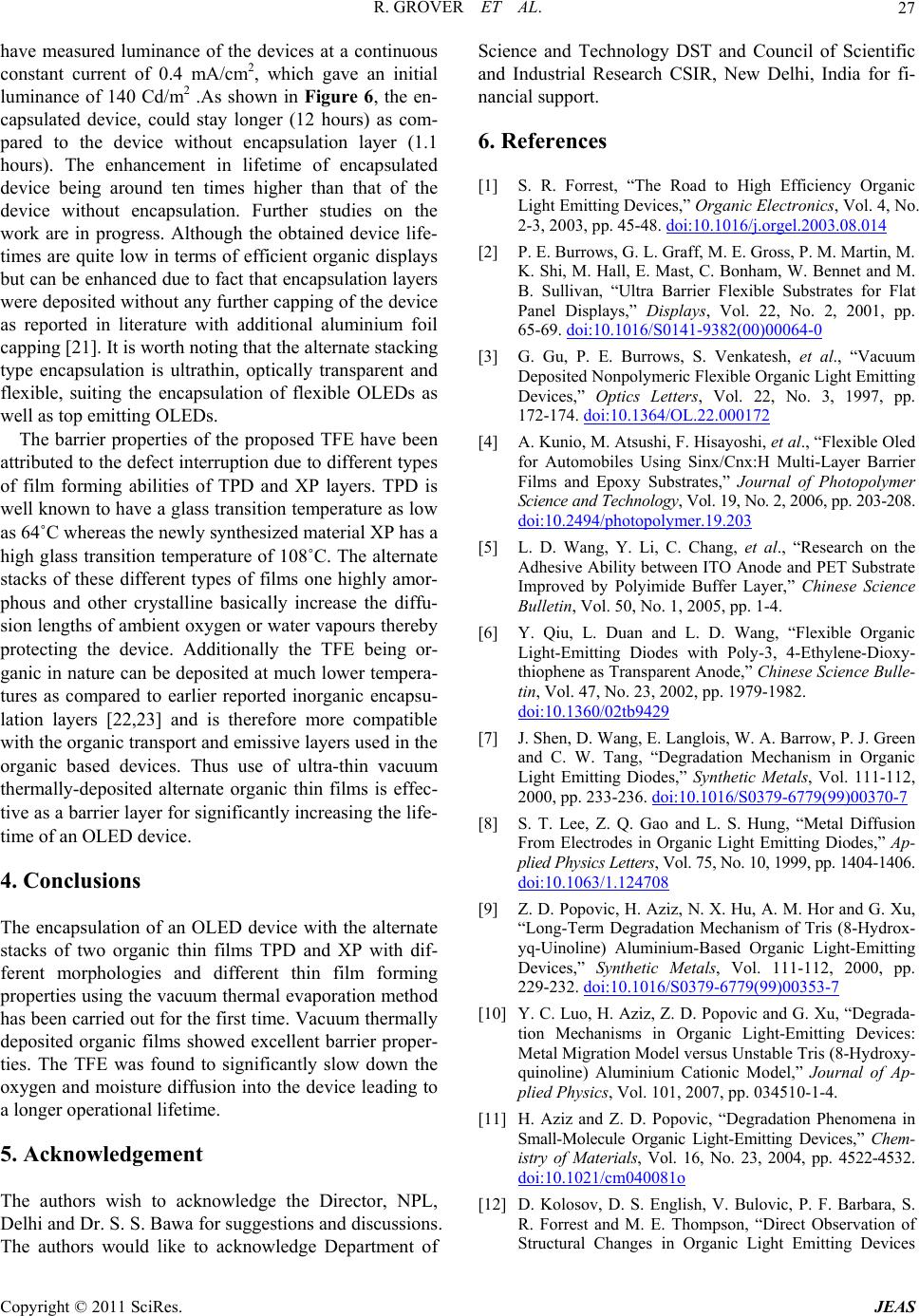
R. GROVER ET AL.27
have measured luminance of the devices at a continuous
constant current of 0.4 mA/cm2, which gave an initial
luminance of 140 Cd/m2 .As shown in Figure 6, the en-
capsulated device, could stay longer (12 hours) as com-
pared to the device without encapsulation layer (1.1
hours). The enhancement in lifetime of encapsulated
device being around ten times higher than that of the
device without encapsulation. Further studies on the
work are in progress. Although the obtained device life-
times are quite low in terms of efficient organic displays
but can be enhanced due to fact that encapsulation layers
were deposited without any further capping of the device
as reported in literature with additional aluminium foil
capping [21]. It is worth noting that the alternate stacking
type encapsulation is ultrathin, optically transparent and
flexible, suiting the encapsulation of flexible OLEDs as
well as top emitting OLEDs.
The barrier properties of the proposed TFE have been
attributed to the defect interruption due to different types
of film forming abilities of TPD and XP layers. TPD is
well known to have a glass transition temperature as low
as 64˚C whereas the newly synthesized material XP has a
high glass transition temperature of 108˚C. The alternate
stacks of these different types of films one highly amor-
phous and other crystalline basically increase the diffu-
sion lengths of ambient oxygen or water vapours thereby
protecting the device. Additionally the TFE being or-
ganic in nature can be deposited at much lower tempera-
tures as compared to earlier reported inorganic encapsu-
lation layers [22,23] and is therefore more compatible
with the organic transport and emissive layers used in the
organic based devices. Thus use of ultra-thin vacuum
thermally-deposited alternate organic thin films is effec-
tive as a barrier layer for significantly increasing the life-
time of an OLED device.
4. Conclusions
The encapsulation of an OLED device with the alternate
stacks of two organic thin films TPD and XP with dif-
ferent morphologies and different thin film forming
properties using the vacuum thermal evaporation method
has been carried out for the first time. Vacuum thermally
deposited organic films showed excellent barrier proper-
ties. The TFE was found to significantly slow down the
oxygen and moisture diffusion into the device leading to
a longer operational lifetime.
5. Acknowledgement
The authors wish to acknowledge the Director, NPL,
Delhi and Dr. S. S. Bawa for suggestions and discussions.
The authors would like to acknowledge Department of
Science and Technology DST and Council of Scientific
and Industrial Research CSIR, New Delhi, India for fi-
nancial support.
6. References
[1] S. R. Forrest, “The Road to High Efficiency Organic
Light Emitting Devices,” Organic Electronics, Vol. 4, No.
2-3, 2003, pp. 45-48. doi:10.1016/j.orgel.2003.08.014
[2] P. E. Burrows, G. L. Graff, M. E. Gross, P. M. Martin, M.
K. Shi, M. Hall, E. Mast, C. Bonham, W. Bennet and M.
B. Sullivan, “Ultra Barrier Flexible Substrates for Flat
Panel Displays,” Displays, Vol. 22, No. 2, 2001, pp.
65-69. doi:10.1016/S0141-9382(00)00064-0
[3] G. Gu, P. E. Burrows, S. Venkatesh, et al., “Vacuum
Deposited Nonpolymeric Flexible Organic Light Emitting
Devices,” Optics Letters, Vol. 22, No. 3, 1997, pp.
172-174. doi:10.1364/OL.22.000172
[4] A. Kunio, M. Atsushi, F. Hisayoshi, et al., “Flexible Oled
for Automobiles Using Sinx/Cnx:H Multi-Layer Barrier
Films and Epoxy Substrates,” Journal of Photopolymer
Science and Technology, Vol. 19, No. 2, 2006, pp. 203-208.
doi:10.2494/photopolymer.19.203
[5] L. D. Wang, Y. Li, C. Chang, et al., “Research on the
Adhesive Ability between ITO Anode and PET Substrate
Improved by Polyimide Buffer Layer,” Chinese Science
Bulletin, Vol. 50, No. 1, 2005, pp. 1-4.
[6] Y. Qiu, L. Duan and L. D. Wang, “Flexible Organic
Light-Emitting Diodes with Poly-3, 4-Ethylene-Dioxy-
thiophene as Transparent Anode,” Chinese Science Bulle-
tin, Vol. 47, No. 23, 2002, pp. 1979-1982.
doi:10.1360/02tb9429
[7] J. Shen, D. Wang, E. Langlois, W. A. Barrow, P. J. Green
and C. W. Tang, “Degradation Mechanism in Organic
Light Emitting Diodes,” Synthetic Metals, Vol. 111-112,
2000, pp. 233-236. doi:10.1016/S0379-6779(99)00370-7
[8] S. T. Lee, Z. Q. Gao and L. S. Hung, “Metal Diffusion
From Electrodes in Organic Light Emitting Diodes,” Ap-
plied Physics Letters, Vol. 75, No. 10, 1999, pp. 1404-1406.
doi:10.1063/1.124708
[9] Z. D. Popovic, H. Aziz, N. X. Hu, A. M. Hor and G. Xu,
“Long-Term Degradation Mechanism of Tris (8-Hydrox-
yq-Uinoline) Aluminium-Based Organic Light-Emitting
Devices,” Synthetic Metals, Vol. 111-112, 2000, pp.
229-232. doi:10.1016/S0379-6779(99)00353-7
[10] Y. C. Luo, H. Aziz, Z. D. Popovic and G. Xu, “Degrada-
tion Mechanisms in Organic Light-Emitting Devices:
Metal Migration Model versus Unstable Tris (8-Hydroxy-
quinoline) Aluminium Cationic Model,” Journal of Ap-
plied Physics, Vol. 101, 2007, pp. 034510-1-4.
[11] H. Aziz and Z. D. Popovic, “Degradation Phenomena in
Small-Molecule Organic Light-Emitting Devices,” Chem-
istry of Materials, Vol. 16, No. 23, 2004, pp. 4522-4532.
doi:10.1021/cm040081o
[12] D. Kolosov, D. S. English, V. Bulovic, P. F. Barbara, S.
R. Forrest and M. E. Thompson, “Direct Observation of
Structural Changes in Organic Light Emitting Devices
Copyright © 2011 SciRes. JEAS